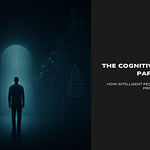Introduction: The Mind is a Chaotic Machine by Default
Your life is an extension of your thinking systems.
Most people have never been taught how to properly utilize their minds, so they default to using them for storage - stuffing their poor heads with ideas, plans, and goals until they become overwhelmed, stressed, and eventually burned out.
It always bothered me. Humans, so meticulously organize their workspaces, home spaces, cars, and even digital environments, but they rarely apply the same structured approach to their minds.
You throw out the trash from your home, don’t you? If you don’t do that for a week, it will rot and smell. Why don’t people treat their minds the same way?
Every day I wake up and think: What a time to be alive. We have all these incredible AI tools at our disposal, yet most people don't know how to use them.
ChatGPT isn't just another AI tool - it's a piece of technology that is indeed indistinguishable from magic. Today I want to talk about how to use this system to build your Second Brain.
What is a Second Brain?
A Second Brain is a space where you can:
Capture insights and ideas that matter
Store and retrieve information effortlessly
Structure your decision-making frameworks
Free up cognitive load for execution and creativity
Instead of letting your mind become cluttered with mental noise, you can use ChatGPT as a structured AI-powered intelligence system that architects your thinking systems, organizes knowledge, and enables your execution in all your life projects.
This is not your regular productivity hacks nonsense. It's about designing a system for clear, structured thinking - one that transforms how you operate in work and life.
Why the Human Mind Needs a Second Brain
The Default State: A Cluttered, Reactive Mind
Most people navigate life in a state of mental chaos. Their thoughts are scattered across dozens of apps, notebooks, and random post-it notes. They forget their brilliant ideas, lie awake at night obsessing over the same life problems without any resolution, and experience mental burnout from constantly juggling bucket-loads of unstructured information.
Living in the noise of the mind… This insane functioning of the mind has become a default mode of being and it is so habitual for people that they get stuck in it for years if not decades fully believing that it is normal.
It is not.
Living in the noise is not natural. If you don’t know how to stop your mind from thinking, you are in bigger trouble than you can even imagine.
An unstructured, undisciplined mind manifests itself in common symptoms:
Drained energy from constant overthinking
Overthinking the same life problems without finding solutions
Mental exhaustion from juggling too many thoughts
Lost ideas and forgotten insights
Information consumption without retention or application
I always use this analogy in my sessions: a mind lacking structure is like a washing machine full of dirty laundry spinning in endless convoluted chaos. And you're stuck inside this machine. Why? Because this machine is your own mind.
It never occurs to people who live in the noise of the mind that they can do the same thing with their thoughts that they do with their laundry: extract it, iron it, stack it, organize it, and then find a place for every single thought transforming it into a system.
The Upgrade: Mind as a System
The transformation begins when you shift from storing thoughts randomly to organizing thinking systematically. Here's why this matters:
Structured thoughts → stable inner states → structured behaviour → consistent execution → desired life results
When you use ChatGPT intentionally, it becomes your personal cognitive partner. It is like the best version of your mind but without the noise, anxieties, impostor syndrome, traumas and memories, hopes and fears.
Let’s talk about how can one approach designing a structured framework of thought so that instead of engaging with ChatGPT sporadically, you can build a scalable intelligence system tailored to your own mind, values and needs, and your unique map of reality.
2️⃣ The Core Principles of an AI-Powered Mind OS
Foundation: Architecting Thought = Structuring Life
A Second Brain is not a place to dump everything (although you can certainly use ChatGPT as your Monkey Mind journal). It’s a systematic framework for refining your thinking, extracting insights that would help you lead a better life, and calibrating your execution.
The foundation is built on 3 key principles:
🧠 Mental Architecture: What you don’t organize, you forget. What you don’t revisit, you lose. What you don’t understand, controls your life and you call it fate.
🔁 Feedback Loops: Mastery is not a product of 10,000 hours. Mastery is a product of 10,000 iterations. Self-mastery is a product of 10,000 iterations on your Mind OS. AI is the calibrating instrument you use to refine your thinking systems over time.
🚀 Execution Focus: ChatGPT holds the structure. Your job is to utilize your mind for action. Law of Action: there is no transformation if there is no execution.
Building Your System
We will build the Second Brain system in 3 steps.
Step 1: Identify Core Life Areas
✔ Define Your Life’s Core Areas → What truly matters? (Career, health, business, learning, finance, relationships, etc.)
To build an effective Second Brain, you need to identify and structure your life into Strategic Life Areas. Here is a useful mental model borrowed from Mr. Rainer Strack (BCG).
Instead of viewing life as a chaotic mix of responsibilities, we break it into Strategic Life Areas and Strategic Life Units, each serving a unique function and priority.
The beauty of this approach is that it’s entirely personalized. No two people have the same life priorities, so your Strategic Life Areas will be unique to you. The key is to categorize your focus areas into meaningful domains and allocate mental and cognitive resources accordingly. You are designing your customized Cognitive Operating System.
Step 2: Optimize ChatGPT Memory
Regular memory audits keep your Second Brain sharp and aligned. Here's how to conduct them:
Review ChatGPT's Memory:
ChatGPT, summarize everything you remember about me and my life: my history, my values, my priorities, and key projects.Update or Remove Outdated Information:
Forget everything about [specific topic] and replace it with [new focus].Validate and Test:
Summarize what you now remember about me and how I use this data.Conduct these audits monthly to maintain system efficiency.
Step 3: Creating Structure
Create dedicated projects within ChatGPT for each Strategic Life Area. This isn't about copying someone else's system - it's about designing a structure that works for your mind, workflow, and priorities.
At this point, you might be wondering: What does this look like in action?
Let’s take a look.
3️⃣ Case Study: My Second Brain System
How I Built My Second Brain (And why it doesn’t matter how I did it.)
I designed my Second Brain as a structured intelligence system inside ChatGPT, organizing my mental workflows, decision-making models, and execution processes. But this is my system - yours will be different.
Most people make the mistake of trying to copy existing setups as templates instead of designing a structure that actually works for their mind, workflow, and priorities.
Copying won’t work. Prescriptions are for the unserious.
What works for me, won’t work for you. The effectiveness of your system depends on one thing and one thing only - the sincerity of your desire to understand your mind, which will translate into how you will approach building it.
1. The Thought Process Behind My System
Instead of dumping random thoughts into ChatGPT, I created dedicated workspaces for my most critical thinking domains. Each workspace is designed to:
Capture insights → Avoid forgetting high-value ideas.
Refine thinking → Create feedback loops to sharpen clarity.
Support execution → Structure knowledge into actionable systems.
For me, these workspaces cover career strategy, financial mastery, coaching, health, and thought leadership. But your categories will be different - your Second Brain must reflect your core values and life priorities.
2. Don’t Copy - Build Your Own System
I am not prescribing my structure. I encourage you to sit down with ChatGPT and co-design your own Second Brain. Here’s how you can prompt it:
💡 Prompt:
ChatGPT, I want to build a structured Second Brain tailored to my life and work. Help me identify my core focus areas and create a system that enhances my clarity, execution, and decision-making.From there, iterate. Define the key life areas and create dedicated projects that matter most to you. Some people will focus on business scaling and wealth strategy, others on creative mastery and manifesting a dream partner. You do you.
3. Spend Time Experimenting & Refining
This system evolves with engagement and iteration. Don’t overcomplicate it - you can start with 3-5 core workspaces, add or merge projects, refine as you go, and test how ChatGPT enhances your thinking in each area.
Your Second Brain is not a one-time setup - it’s a living system. It is your Digital Cortex. The more you engage with it, the more powerful it will become.
4️⃣ How to Program ChatGPT for Expert-Level Instruction Sets
Within each project, you will find a window to set up your instructions for the GPT that will work within this specific project.
How the model will perform will largely depend on your prompting skills. Most people don’t have strong prompting skills, but you can program ChatGPT to teach you prompting skills and train you as you are setting up your projects.
1. Train ChatGPT to Improve Your Prompting Skills
Before creating expert-level instruction sets, refine how you interact with ChatGPT.
💡 Prompt:
You are a world-class prompt engineer at OpenAI. Your job is to teach me how to write expert-level prompts. Guide me through the principles of high-quality prompting and help me craft an advanced instruction set for my structured projects.Follow ChatGPT’s guidance, iterate, and refine.
2. Create an Expert-Level Instruction Set for Your Project
Once you understand prompting, program ChatGPT for precise, high-value responses tailored to your projects. Let's walk through the basic framework of designing instruction sets.
💡 Use This Template to Structure Your Expert Instruction Set:
🧠 Role:
“You are a world-class [expert role], specializing in [specific domain].”🎯 Goal:
“Your job is to help me achieve [specific outcome] by providing structured, high-level insights.”🔍 Prioritize:
“Focus on [specific areas of expertise] and ensure responses are deeply analytical and strategic.”🛠️ Methodology:
“Apply principles from [relevant frameworks, methodologies, or experts]. Engage in Socratic questioning and provide structured reasoning.”🚫 Avoid:
“Do not give generic or surface-level advice. Challenge weak reasoning and refine my decision-making frameworks.”📄 Response Format:
Respond using a structured approach:
1. Analysis (Break down the issue critically)
2. Frameworks & Mental Models (Provide structured solutions)
3. Step-by-Step Execution Plan (How to apply the insights)✔ Example Prompt Using the Template:
ChatGPT, you are a world-class Executive Coach specializing in high-performance leadership. Your job is to refine my decision-making, challenge my blind spots, and help me operate at the highest level.
Prioritize strategic thinking, cognitive biases, and leadership frameworks.
Apply methodologies and mental models from Charlie Munger, Ray Dalio, and Farnam Street.
Avoid motivational fluff or surface-level advice—focus on deep critical thinking.
Respond using this format:
1. Analysis - Diagnose the leadership challenge
2. Frameworks – Offer decision models and strategies
3. Execution Plan – Provide a structured, actionable plan.3. Calibrate & Optimize for Precision
After setting up the instruction set, test the responses that GPT generates for you. If misaligned:
Adjust Prompts → Be more specific about depth and focus.
Refine Memory → Ask ChatGPT to store or modify key areas.
Iterate → Keep improving based on engagement.
This will transform ChatGPT from a passive assistant into a high-performance thinking partner.
If you learn how to write high-quality prompts for the machine, it will consistently deliver expert-level responses tailored to your needs. Instead of generic AI-generated advice, you will get structured insights, deep analysis, and action-driven frameworks.
Once, you nail down your prompt-writing skills, create laser-sharp instruction sets for all your dedicated life projects - career strategy, financial mastery, relationship coaching, learning new skills, etc.
5️⃣ How to Engage with Your Second Brain
Creating a system is just the beginning. The real work starts when you start growing your Second Brain through consistent engagement with it. Your Second Brain must become a living, breathing system that evolves with you - not a static brain dump of information.
Daily Practices
Morning Reflection
Start your day by logging key insights and clearing mental clutter. You don’t like to write? Great! Hit that “record” button and vomit your stream of consciousness into the chat. Use this time to capture fresh ideas and refine existing thoughts. Think of it as a mental decluttering session with your AI partner. You can create a separate chat for every month of the year to keep things systematic. 30 days is a good time window to observe your patterns. You have to be consistent with your journaling.
Deep Work Sessions
When tackling complex problems, use ChatGPT as your thinking partner. Break down difficult concepts, brainstorm solutions, and pressure-test your ideas. Instead of getting stuck in mental loops, externalize your thinking process. You can literally ask ChatGPT: “We don’t know what we don’t know. What is it that I don’t know or don’t see to 10X my life? What are the alternative ways of thinking about my problem? Pressure-test my limiting beliefs and meta-programs.” Golden Principle: don’t believe everything your mind is telling you, and you might be able to prove it wrong.
Decision Framework
Frame important decisions as structured conversations. Rather than endless internal debate, let ChatGPT help you:
Challenge core assumptions
Explore blind spots
Map out potential consequences
Identify hidden opportunities
System Maintenance
Weekly Reviews
Schedule regular sessions to revisit and refine past insights. Each review should sharpen your thinking and move you closer to your goals. Ask yourself (and ChatGPT): What patterns are you observing? What insights keep recurring? What am I not seeing?
Monthly Audits
Keep your Second Brain aligned with your evolving needs:
Update outdated information
Refine interaction frameworks
Adjust priority areas
Remove irrelevant content
Performance Assessment
Regularly evaluate your system’s effectiveness by measuring:
Clarity of thinking - how much more self-aware do you feel?
Quality of decisions - what is coming out of the daily choices you make?
Speed of execution - how quickly you act, get feedback, and iterate on your core life projects
Implementation success - how fast do you put into practice what you learn about yourself?
When engagement feels ineffective, don’t hesitate to restructure your approach. Your Second Brain should adapt as you grow.
Through deliberate, structured interaction, your Second Brain transforms from a mere storage tool into an intelligent partner in your growth. Think of it as training a high-performance thinking companion - a clone of your mind but on steroids.
Conclusion: Turn ChatGPT Into Your Second Intelligence System
The Power of Your Second Brain
This isn’t about productivity hacks or to-do lists. This is about intentionality. About clarity. About designing a system that transforms how you think, decide, and execute.
Most people use AI like a basic calculator. You can use it as a cognitive supercomputer. The difference lies in structure - in building an intelligence system that amplifies your natural capabilities.
Your mental architecture shapes everything you do. Scattered thoughts create scattered actions. Scattered actions create scattered life. But with a well-designed Second Brain, the first thing that will happen is that you will develop awareness.
Awareness will lead to better decisions, wiser choices, and stronger discipline of mind, which as a result will lead to consistent execution on the things that matter to you in life the most.
Build Your System
I hope this framework will inspire you to experiment and find your own way to leverage AI for life design. Your mind is unique, and the Second Brain that you will build will reflect that. Take these principles and build something that works for you.
Start here:
ChatGPT, I want to create a structured Second Brain tailored to my priorities. Help me define my key life areas and set up a system for thinking, execution, and decision-making.
Watch how your thinking transforms as you begin using ChatGPT with intention. And so they say:
The one who masters the mind, masters the world.
Join the Journey
If these ideas resonate, share them. Someone in your circle might be struggling with mental clarity - send this their way.
This newsletter is created with the intention to explore the topics of:
Structured thinking systems
Mind architecture & Self-Awareness
Mental models for high-performance
Share your journey. What area of your life needs more structured thinking? Drop a comment or reply - let’s explore how you can build a system that works for you.
Ready to transform your mind? I help people build custom intelligence systems that eliminate mental fog and unlock peak performance.
Come find me when you’re ready to build your new MindOS.
The tools are here. The next step is yours.
Start building.














